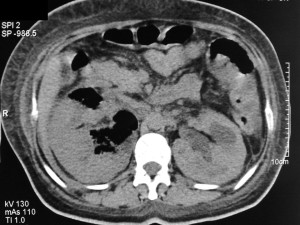Difference Between Pyelitis and Pyelonephritis
Pyelitis and pyelonephritis are inflammatory diseases affecting the kidneys. Pyelitis is a condition which affects renal pelvis which is a part of the kidney and causes inflammatory changes in the lining of the renal pelvis. Pyelonephritis, in contrast, is an inflammation of the main renal tissue (parenchyma, calyces) and the renal pelvis.
Difference in causes:
Inflammation of the pelvis (pyelitis) is most commonly the result of infection by bacteria and the condition is usually short lived. It is often neglected, and thus spreads to the deeper tissues of the kidney affecting calyces and parenchyma which is then known as pyelonephritis. Pyelitis is commonly caused by a bacterial infection that spreads up the urinary tract beginning from the urethra. Urinary tract infection is the most common cause, produced by organisms such as E. coli. Other organisms such as pseudomonas and klebsiella may also cause urinary tract infections. Cases of Pyelonephritis start as a lower urinary tract infection, mainly cystitis or a bladder inflammation. Other causes of pyelonephritis include kidney stones that produce obstruction and stasis of urine outlet and act as a foci for infection; urinary tract catheterization, structural abnormality in the urinary tract, vesicoureteral reflux which is the most common cause in children younger than 6 years (urine from the bladder flowing back into kidney), pregnancy, diabetes, enlarged prostate, cancer of prostate, neurogenic bladder, polycystic kidney, kidney tuberculosis causing renal tissue damage and recurrent urinary tract infection.
Difference in presentation:
Pyelonephritis is classified into acute pyelonephritis and chronic pyelonephritis. In acute pyelonephritis, there is a sudden localized inflammation of the renal pelvis and collecting tubules of the kidney and the kidney’s filtration function and the blood vessels are still preserved. Chronic pyelonephritis refers to long-standing infection due to recurrent kidney infections results in scarring of renal tissue and impaired kidney function.
Symptoms of pyelitis and pyelonephritis are similar but symptoms of pyelitis are less severe as compared to pyelonephritis. Common symptoms are pain while urination, burning pain while urination, blood in urine, cloudy urine with increased frequency of urination and decreased urinary output, associated with pain in the back at the renal angle, erratic pattern of fever with chills, nausea, vomiting , general malaise and weakness. Children may present with fever alone or associated with vomiting, convulsion, irritability, abdominal distension and weakness. Symptoms may develop over few hours to one day.
Diagnosis is generally based on history and medical examination. Urine analysis may show pus and blood cells with urine culture positive for bacteria. Ultrasonography and CT scan for kidney stones or structural abnormalities such as polycystic kidney or vesico-ureteric reflux. DMSA radionuclide scan is the most reliable test for diagnosis of acute pyelonephritis. Renal function tests might show increased levels of serum creatinine and blood urea nitrogen.
Treatment is the same for both and includes intravenous hydration, lots of water orally, antibiotics oral or intravenous. Choice of antibiotics depends on the organism and antibiotic sensitivity test performed on the urine culture. Antibiotics are given for 10 to 14 days. A surgery called as Percutaneous nephrostomy or a ureteral stent placement may be indicated to relieve obstruction caused by stone. In severe cases, nephrectomy that is removal of kidney is suggested.
SUMMARY:
Pyelitis is the inflammation of renal pelvis which is a part of a kidney from where the kidney empties into the ureter whereas pyelonephritis includes inflammation of the entire kidney. Signs and symptoms are generally same. The two conditions are generally caused due to an ascending urinary tract infection. Treatment includes antibiotic therapy along with lots of liquids to hydrate.
- Difference between near sightedness and far sightedness - January 21, 2015
- Difference between Diverticulosis and Diverticulitis - January 20, 2015
- Difference between Prilosec and Nexium - January 19, 2015
Search DifferenceBetween.net :
Leave a Response
References :
[0]http://images.radiopaedia.org/images/539152/f62300feef4ea6332658bef16e012a.JPG

